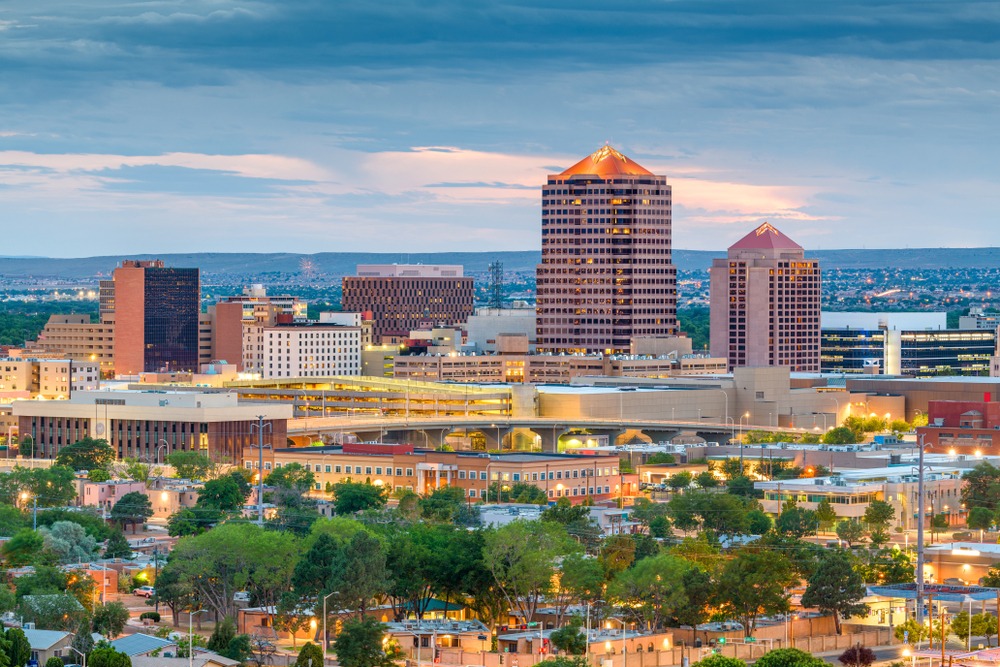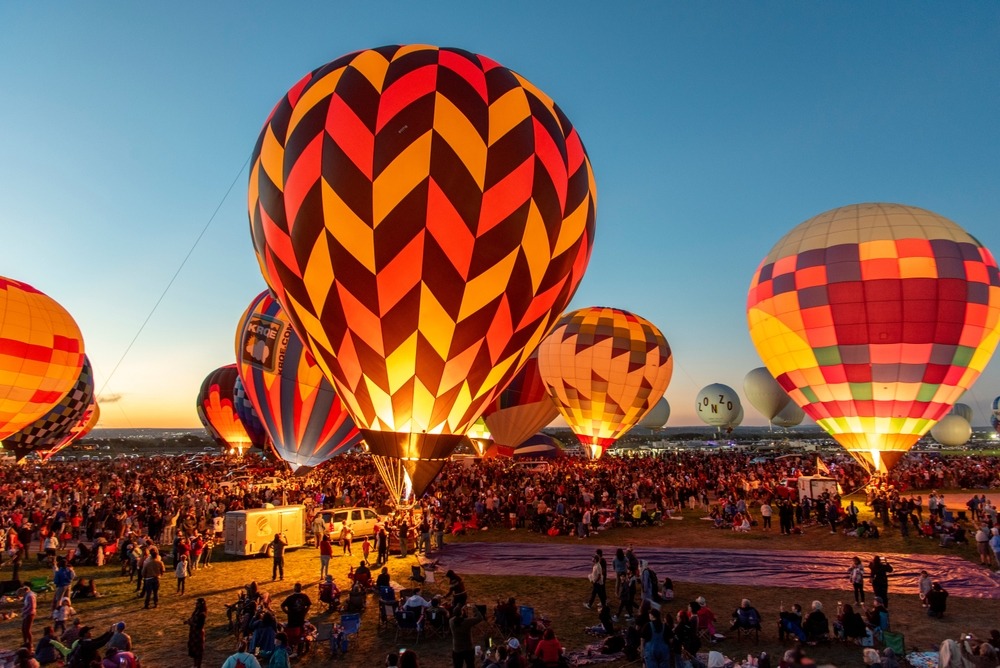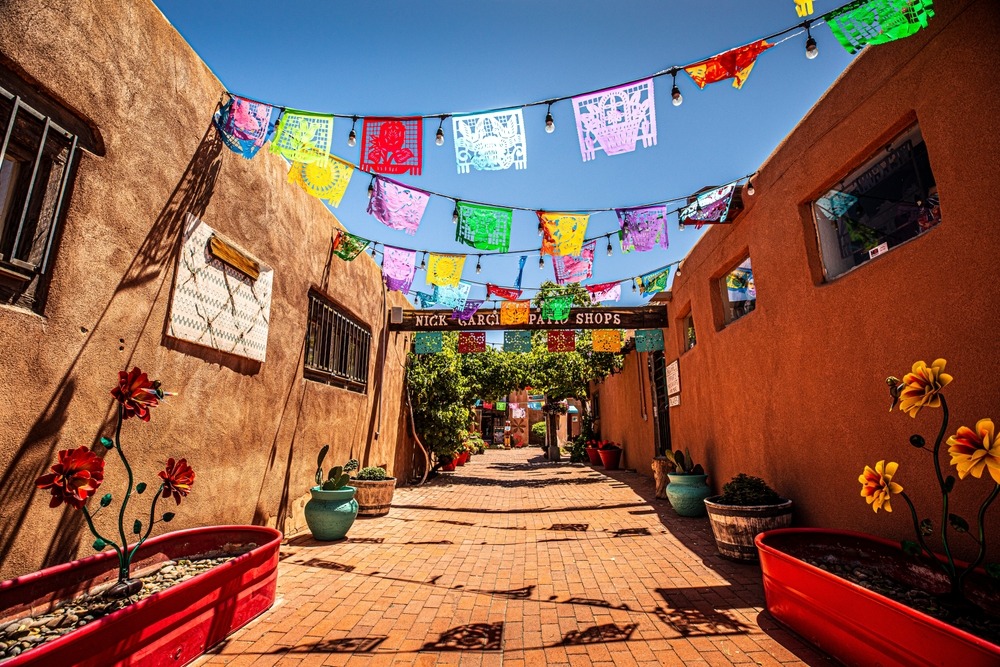History and Attractions of Albuquerque, New Mexico
Albuquerque sits at the intersection of ancient cultures, colonial legacies, and modern innovation. Located in the heart of the Rio Grande Valley, the area has been continuously inhabited for thousands of years.

Indigenous Roots
Long before the arrival of Spanish colonizers, the region was home to Ancestral Puebloans and later Tiwa-speaking peoples, whose descendants still live in nearby pueblos such as Isleta, Sandia, and Laguna. These communities built adobe villages, developed advanced irrigation systems, and maintained deep spiritual and cultural connections to the land.
Spanish Colonization
In 1706, Governor Francisco Cuervo y Valdés officially founded the colonial town as La Villa de Alburquerque, named in honor of the Spanish Duke of Alburquerque. The extra “r” was eventually dropped. This settlement was part of the Spanish strategy to colonize and Christianize the region, and the town grew around a central plaza—now Old Town Albuquerque.
Mexican and American Transitions
After Mexico won independence from Spain in 1821, Albuquerque became part of the Mexican Republic. Following the Mexican-American War, the city was annexed into the United States in 1848 through the Treaty of Guadalupe Hidalgo. In 1912, New Mexico became the 47th U.S. state, with Albuquerque evolving into a major Southwestern city.
Growth and Modernization
The arrival of the railroad in 1880 transformed Albuquerque into a hub for trade and transportation. This development led to the rise of “New Town,” located east of the original plaza. In the 20th century, Route 66 ran directly through the city, boosting tourism, motels, and diners.
Albuquerque played a vital role in military and scientific advancements, particularly during and after World War II. Nearby Sandia National Laboratories and Kirtland Air Force Base contributed to the city’s economy and technological importance.
Today, Albuquerque blends old and new—pueblo traditions, Spanish colonial heritage, and Native American cultures coexist with aerospace research, film production, and a vibrant arts scene. It’s also known as the ballooning capital of the world, thanks to its clear skies, calm winds, and iconic annual festival.
Top 25 Attractions in Albuquerque, New Mexico
1. Old Town Albuquerque
The historic heart of the city, with adobe buildings, art galleries, shops, museums, and the 18th-century San Felipe de Neri Church.
2. Albuquerque International Balloon Fiesta
The world’s largest hot air balloon festival, held each October with over 500 colorful balloons in flight.
3. Sandia Peak Aerial Tramway
A thrilling 2.7-mile ride up the Sandia Mountains with panoramic views of the Rio Grande Valley.
4. Indian Pueblo Cultural Center
A vibrant museum and cultural center showcasing the history, art, and traditions of New Mexico’s 19 pueblos.
5. Petroglyph National Monument
Thousands of ancient symbols and images etched into volcanic rock by Indigenous and early Spanish settlers.
6. ABQ BioPark Zoo
A family favorite with exotic animals, lush habitats, and conservation exhibits in the heart of the city.
7. ABQ BioPark Botanic Garden
An oasis of desert plants, Mediterranean gardens, and butterfly pavilions adjacent to the zoo.
8. Albuquerque Museum
Art and history come together in this museum featuring regional artists, colonial artifacts, and traveling exhibits.
9. Explora Science Center and Children’s Museum
An interactive and hands-on museum with STEAM exhibits for kids and curious adults alike.
10. New Mexico Museum of Natural History and Science
Home to dinosaur skeletons, a planetarium, and immersive exhibits on the natural world.
11. Route 66 Landmarks
Cruise along Central Avenue for vintage neon signs, diners, motels, and retro roadside Americana.
12. Tingley Beach
A scenic spot with fishing ponds, walking trails, and paddle boats just west of the BioPark.
13. KiMo Theatre
A historic Pueblo Deco theater that hosts concerts, films, and performances in an ornate, culturally rich venue.
14. San Felipe de Neri Church
Built in 1793, this adobe Catholic church anchors Old Town and remains one of the city’s oldest buildings.
15. Balloon Museum (Anderson-Abruzzo Albuquerque International Balloon Museum)
Dedicated to the history and science of ballooning with interactive exhibits and stunning views.
16. National Hispanic Cultural Center
A multidisciplinary cultural space offering theater, dance, music, and exhibits celebrating Hispanic heritage.
17. University of New Mexico Campus
An architectural gem and cultural hub with museums, public art, and lush landscaping in the Nob Hill district.
18. Nob Hill
A trendy and walkable neighborhood filled with vintage boutiques, cafes, art galleries, and nightlife.
19. Elena Gallegos Open Space
A beautiful nature preserve in the foothills of the Sandia Mountains, popular for hiking, picnicking, and wildlife viewing.
20. Paseo del Bosque Trail
A 16-mile path through the cottonwood bosque along the Rio Grande—ideal for biking, running, or birdwatching.
21. Casa Rondeña Winery
A peaceful vineyard and tasting room offering local wines in a lush North Valley setting.
22. Rio Grande Nature Center State Park
Explore wetlands, wildlife, and interactive nature exhibits along the river’s edge.
23. Downtown Growers’ Market
Held weekly during the warmer months, this vibrant market showcases local produce, food trucks, and live music.
24. Unser Racing Museum
A tribute to the legendary Unser family and the world of IndyCar racing, featuring vintage cars and memorabilia.
25. Hinkle Family Fun Center
A family-friendly amusement park with mini-golf, go-karts, laser tag, and arcade games for all ages.
Conclusion
Albuquerque is a city of contrasts and confluences—where ancient petroglyphs lie minutes from modern research labs, and hot air balloons drift over adobe churches and neon-lit diners. With its dramatic desert landscapes, rich cultural fabric, and diverse attractions, Albuquerque welcomes visitors to explore the rhythms of the Southwest at their own pace. Whether you’re wandering through centuries-old plazas or watching the sunrise from Sandia Peak, there’s a story waiting for you in every direction.



































